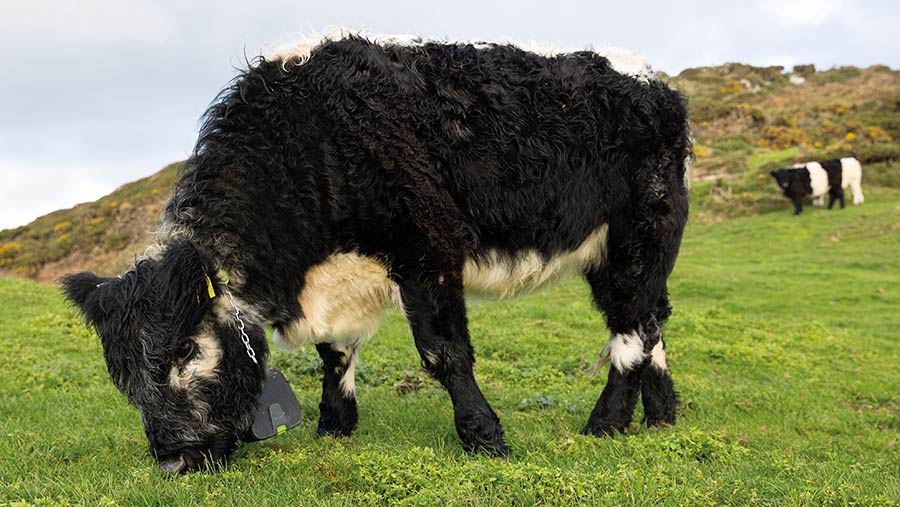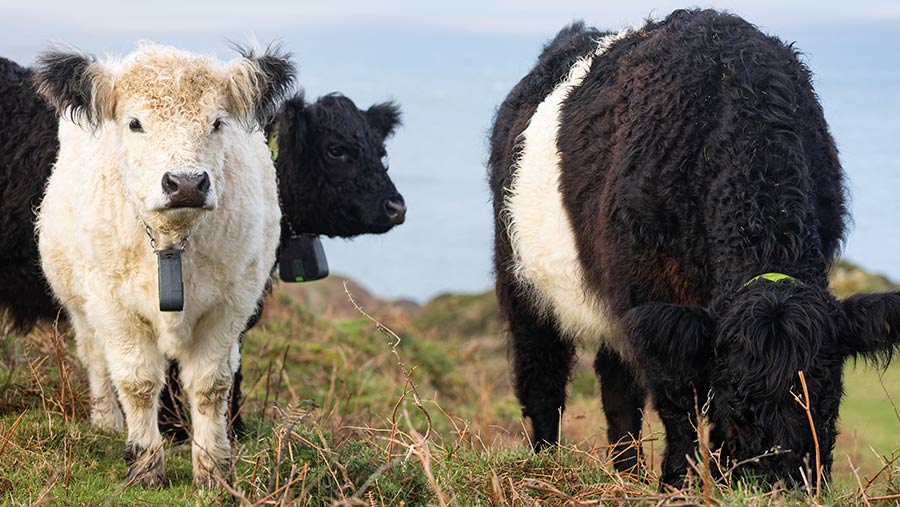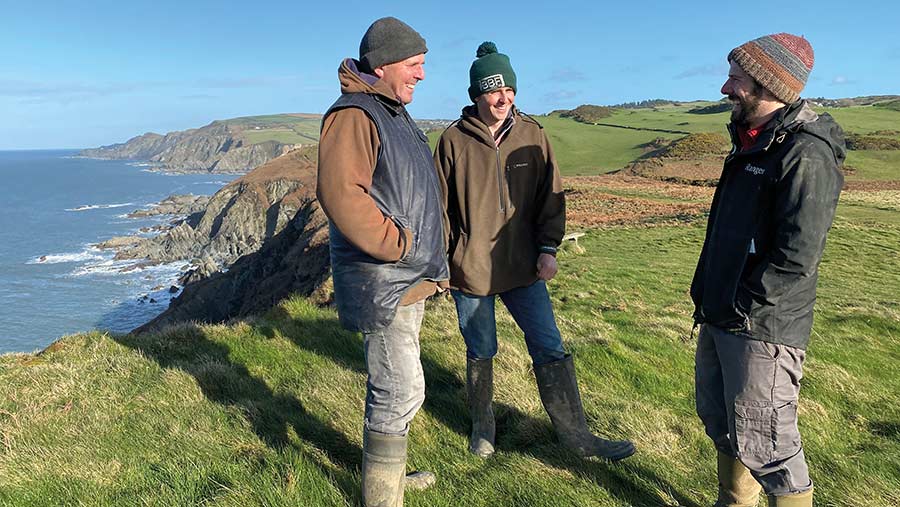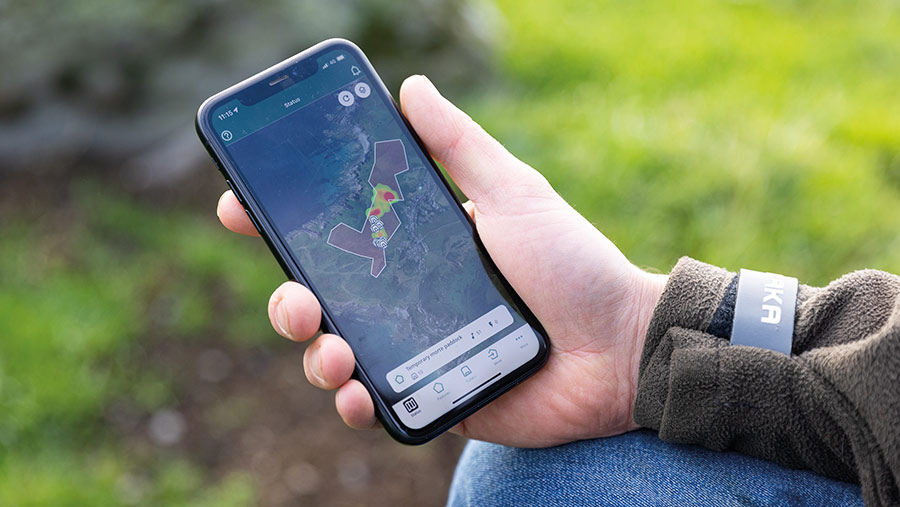Benefits of switching to cattle and virtual fencing
 © Andy Casey/Upright Media
© Andy Casey/Upright Media Virtual fencing technology is helping give livestock production a future on a north Devon farm with one of England’s steepest and most spectacular coastlines.
David and Debbie Kennard, who farm with their son, Nick, at Borough Farm, Mortehoe, had thought that without support from the Basic Payment Scheme, keeping livestock in the protected landscape would no longer be tenable.
See also: How protected landscapes scheme is funding farm improvements
To make matters worse, regular incidents involving walkers with dogs had seen sheep lost over cliff edges.
However, the National Trust, from which the Kennards rent 140ha (346 acres) of coastal land, was keen to see farming continue and wanted to help its tenants move towards a more regenerative and sustainable system.
This would ideally involve replacing sheep – they currently run 500 Exmoor Mule ewes – with a low stocking rate of cattle on their coastal areas.

© Andy Casey/Upright Media
Farm facts: Borough Farm, Mortehoe
- 213ha (526 acres), including 140ha (346 acres) of coastline and site of special scientific interest land rented from the National Trust
- Sheep numbers cut from 700 to 500 and 40 Belted Galloway cattle introduced
- Nofence collars used to keep cattle off cliff edge and South West coast path
- Length of coastline grazed has increased since 2019 from 1.5 miles to 4 miles
- Up to 150 ewes will also be grazed on the coast over the summer months
But as David explains: “We’re on the South West Coast Path and 100,000 visitors walk through every year, so that rules out keeping bulls and cows with calves.”
Virtual fencing lines
The solution was found with the help of a virtual fencing product that uses GPS to retain stock within a boundary mapped out on an app.
Collars with solar-powered batteries fitted to each animal play an audible melody that teaches stock not to cross the virtual fence line.
This Nofence system is used to control grazing for up to 40 head of Belted Galloways, which were bought in batches as yearlings from nearby Dartmoor to rear on the clifftop and adjoining farmland.
Here, they are kept without supplementary feeding – a requirement stipulated by Natural England on the Morte Point site of special scientific interest (SSSI) – and finished by three years of age.
“Our National Trust ranger had trialled the Nofence system on Exmoor and encouraged us to give it a go,” says Nick, who joined the farm after studying agriculture and animal nutrition at Harper Adams University.
“We began with 20 collars and trained the cattle in a field with fixed boundaries, positioning the virtual boundary just inside the actual hedge.
“Within three weeks, we started removing the solid boundary, first by taking off a corner of the field and checking the cattle did not cross the line,” he says.
This can be double-checked on the app, which maps the position of each animal wearing a collar at any time and sends phone alerts if an animal crosses the line.

David (left) and Nick Kennard with Paul South (right) © Ann Hardy
The process involves the cattle hearing the signal as they approach the virtual boundary and only feeling a pulse if they move too close to that line.
They quickly learn to associate the sound with the impending pulse and avoid approaching the boundary another time.
“We have been quite impressed,” says David. “And since we introduced the cattle to the clifftop area, we haven’t recorded any that have strayed.”
This has allowed cattle to graze right up to the coastal path without reaching the dangerous clifftops and with none being lost over the edge.
Grazing habits
National Trust ranger Paul South has helped the Kennards manage the plan.
He explains that, unlike sheep, whose selective grazing targets soft grasses and flowers, and whose light footprint does nothing to suppress bracken, cattle graze fairly unselectively.
They will tear all species of grass and even clear scrub, including brambles and blackthorn.
“Our natural flora evolved with large grazing herbivores such as oryx and bison, which would graze an area and move on, due to predation,” he says.
“By using the collars, the cattle are mimicking that pattern of behaviour, mob-grazing an area and pushing into bracken and scrub.”
All of this provides an opportunity for new growth as light reaches the ground, new seeds are stamped in, and land is then rested as stock are moved away for several weeks or months.
This allows areas previously shaded by bracken and scrub to support new mosaics of habitat and boost newly introduced and diverse plant species in the opened-up ground.
And with new habitats comes more insect and mammalian life, performing functions such as burying dung, cycling nutrients, capturing carbon, pollinating wildflowers and feeding more life up the food chain.
The National Trust is closely monitoring these outcomes, although it has yet to gather complete sets of data to compare with vegetation mapped at the outset.
“Anecdotally, I can see such a difference,” says Mr South. “The cattle came here in December 2019 and already there are structural changes in the vegetation, such as less bracken and more primroses.”

Nofence app © Andy Casey/Upright Media
Premium potential
Both parties praise the working relationship, which has helped the National Trust qualify for Higher-Level Stewardship and created sustainable management processes.
At the same time, it has provided the Kennards with a means of producing low-input, native-breed, grass-fed beef, potentially at a premium price.
“At the moment, we just sell to the abattoir, usually at R3H grade, and must reach a carcass weight of 250kg,” says David.
“This is just achievable, but if we don’t reach it, we’ll lose at least 40p/kg.”
The only drawback they have experienced so far is the loss of battery charge as the collars’ solar panels become scratched by the blackthorn and gorse.
And, while the financial investment was grant-funded on his farm, he thinks it may not be viable in some situations.
“I also feel a little vulnerable to changes in the price of the app and may feel concerned about keeping cattle alongside a main road without a perimeter fence,” he adds.
However, the team says the virtual fencing is allowing conservation and farming to co-exist to the benefit of all involved.
“The National Trust is committed to making it sustainable for us as well as for coastal habitat management,” says David.
“I think we are on the way to making it work.”
How much did the technology cost?
- The Nofence collars for Borough Farm each cost £240 (+VAT) and required an annual subscription of £931 (+VAT) for 20 cattle. This will increase as numbers go up.
- The system qualified for grant funding through the Farming in Protected Landscapes scheme, reducing the cost of the collars by 70%
- The cost is considered to be small in relation to the price of fencing a rocky coastline, which is physically difficult and aesthetically unacceptable
- Solar panels within the collar charge its batteries, providing power to use day and night
